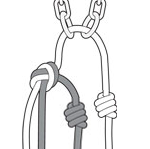Learn This: Preferred Knots for Rappelling

"HPRapKnots"
As a mountain guide, two questions I’m often asked are: 1) What knot do you use to join two ropes for rappels? and 2) Which knot do you use to tie the end of the ropes for a backup?

1. Joining Ropes
The knot I use to tie together two ropes for a rappel—and one we commonly use in guides’ training at the AMGA—is the flat overhand. This knot has been called a number of things (including the Euro death knot) and has at times been unfairly demonized. When used correctly, the flat overhand knot is superior for rigging a rappel. It works well with ropes of different diameter, and no matter what orientation it starts in, when it comes time to pull the ropes, the knot shifts into an advantageous position to avoid snagging or getting stuck.
This knot gets its bad reputation because under certain loads it will roll or capsize. Pull tests showed that the flat overhand rolled multiple times under a heavy load, sucking the tails toward the knot. But the knots in these tests had tails at least a foot long, and before the tails were sucked through the knot, the rope broke at around 2,000 lbs. With this in mind, and since you’re unlikely to generate 2,000 lbs. of force in a rappel situation, the ease of pulling ropes tied with the flat overhand far outweighs any strength concerns. However, when you’re tying ropes together for a long toprope or tying cord for slings, always use a knot less prone to rolling, such as the double fisherman’s or Flemish bend.
As with any knot, the effectiveness of the flat overhand depends on how well it is tied. The key points are: 1. Be sure the knot is well dressed (no crossed strands). 2. Tighten the knot aggressively—pull each strand tight on either side of the knot. 3. Leave 12 to 18 inches of tail on each strand.
2. Knotting the Ends
It’s always a good idea to knot the ends of rappel ropes to avoid the fatal mistake of slipping off the ends. I like to knot the strands individually, because this allows any would-be kinks to dissipate off the ends of the ropes. My choice of knot is the triple barrel. This knot is very clean, stays tied, and creates a stopping point that will not slip through any device.
Rob Hess, a licensed IFMGA/UIAGM mountain guide, is owner and chief guide of Jackson Hole Mountain Guides (jhmg.com). He served as technical director for the AMGA for eight years.